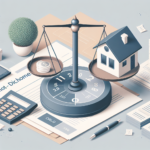Introduction
Securing a mortgage after experiencing bankruptcy or foreclosure may seem daunting, but it is entirely possible with the right strategies and understanding. This guide will provide you with insights into the steps you need to take to improve your financial standing and eventually secure a mortgage. While the path may require patience and diligence, the end goal of owning a home is achievable.
Understanding Bankruptcy and Foreclosure
Before delving into the steps to secure a mortgage, it’s important to understand what bankruptcy and foreclosure entail:
- Bankruptcy: A legal process in which individuals or businesses unable to meet financial obligations can seek relief from some or all of their debts. There are different types of bankruptcy filings, with Chapter 7 and Chapter 13 being the most common for individuals.
- Foreclosure: A legal process through which a lender takes control of a property after the borrower fails to make mortgage payments. This results in the lender selling the home to recover the outstanding debt.
Impact on Credit Score
Both bankruptcy and foreclosure have significant impacts on your credit score, which is a critical factor in securing a mortgage. Here’s a brief look at how each affects your credit:
| Event | Impact on Credit Score | Duration on Credit Report |
|---|---|---|
| Chapter 7 Bankruptcy | Can lower score by 200 points or more | Up to 10 years |
| Chapter 13 Bankruptcy | Typically lowers score by 150-200 points | Up to 7 years |
| Foreclosure | Can decrease score by 85-160 points | Up to 7 years |
Steps to Improve Credit Score
Improving your credit score is a crucial step in securing a mortgage. Here are actionable steps you can take:
- Review Your Credit Report: Obtain copies of your credit reports from the three major bureaus (Equifax, Experian, TransUnion) and check for errors.
- Pay Bills on Time: Consistently paying all bills on time can gradually improve your credit score.
- Reduce Debt: Work on paying down high-interest debts first, and try to maintain a low credit utilization ratio.
- Consider Credit Counseling: Seek advice from credit counseling services to help manage and improve your financial situation.
Waiting Periods for Mortgage Approval
After a bankruptcy or foreclosure, there are required waiting periods before you can apply for a mortgage:
- FHA Loans: Typically require a 2-year waiting period after Chapter 7 bankruptcy and 3 years after foreclosure.
- VA Loans: Usually require a 2-year waiting period after bankruptcy or foreclosure.
- Conventional Loans: Generally, a 4-year waiting period after Chapter 7 bankruptcy and 7 years after foreclosure.
Choosing the Right Mortgage
After the waiting period and improving your credit score, it’s essential to select the right type of mortgage. Consider these options:
- FHA Loans: These are often more accessible for individuals with lower credit scores and smaller down payments.
- VA Loans: Available to veterans and active-duty service members, they offer competitive terms and no down payment requirements.
- Conventional Loans: These may offer better interest rates for those with improved credit scores.
Conclusion
While securing a mortgage after bankruptcy or foreclosure is challenging, it is certainly within reach with careful planning and persistence. Focus on rebuilding your credit, understanding the waiting periods, and choosing a suitable mortgage option. By following these guidelines, you can achieve the dream of homeownership once again.




